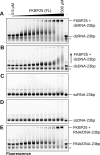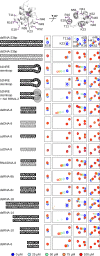The basic tilted helix bundle domain of the prolyl isomerase FKBP25 is a novel double-stranded RNA binding module
- PMID: 29036638
- PMCID: PMC5714180
- DOI: 10.1093/nar/gkx852
The basic tilted helix bundle domain of the prolyl isomerase FKBP25 is a novel double-stranded RNA binding module
Abstract
Prolyl isomerases are defined by a catalytic domain that facilitates the cis-trans interconversion of proline residues. In most cases, additional domains in these enzymes add important biological function, including recruitment to a set of protein substrates. Here, we report that the N-terminal basic tilted helix bundle (BTHB) domain of the human prolyl isomerase FKBP25 confers specific binding to double-stranded RNA (dsRNA). This binding is selective over DNA as well as single-stranded oligonucleotides. We find that FKBP25 RNA-association is required for its nucleolar localization and for the vast majority of its protein interactions, including those with 60S pre-ribosome and early ribosome biogenesis factors. An independent mobility of the BTHB and FKBP catalytic domains supports a model by which the N-terminus of FKBP25 is anchored to regions of dsRNA, whereas the FKBP domain is free to interact with neighboring proteins. Apart from the identification of the BTHB as a new dsRNA-binding module, this domain adds to the growing list of auxiliary functions used by prolyl isomerases to define their primary cellular targets.
© The Author(s) 2017. Published by Oxford University Press on behalf of Nucleic Acids Research.
Figures








Similar articles
-
Basic Tilted Helix Bundle - a new protein fold in human FKBP25/FKBP3 and HectD1.Biochem Biophys Res Commun. 2014 Apr 25;447(1):26-31. doi: 10.1016/j.bbrc.2014.03.068. Epub 2014 Mar 22. Biochem Biophys Res Commun. 2014. PMID: 24667607 Free PMC article.
-
The prolyl isomerase, FKBP25, interacts with RNA-engaged nucleolin and the pre-60S ribosomal subunit.RNA. 2014 Jul;20(7):1014-22. doi: 10.1261/rna.042648.113. Epub 2014 May 19. RNA. 2014. PMID: 24840943 Free PMC article.
-
Structural basis of nucleic acid recognition by FK506-binding protein 25 (FKBP25), a nuclear immunophilin.Nucleic Acids Res. 2016 Apr 7;44(6):2909-25. doi: 10.1093/nar/gkw001. Epub 2016 Jan 13. Nucleic Acids Res. 2016. PMID: 26762975 Free PMC article.
-
Resolving the functions of peptidylprolyl isomerases: insights from the mutagenesis of the nuclear FKBP25 enzyme.Biochem Soc Trans. 2013 Jun;41(3):761-8. doi: 10.1042/BST20130013. Biochem Soc Trans. 2013. PMID: 23697935 Review.
-
Prolyl cis-trans isomerization as a molecular timer.Nat Chem Biol. 2007 Oct;3(10):619-29. doi: 10.1038/nchembio.2007.35. Nat Chem Biol. 2007. PMID: 17876319 Review.
Cited by
-
Identification and Functional Analysis of Rare HECTD1 Missense Variants in Human Neural Tube Defects.Res Sq [Preprint]. 2024 Jan 2:rs.3.rs-3794712. doi: 10.21203/rs.3.rs-3794712/v1. Res Sq. 2024. Update in: Hum Genet. 2024 Mar;143(3):263-277. doi: 10.1007/s00439-024-02647-4. PMID: 38260607 Free PMC article. Updated. Preprint.
-
Molecular details of the CPSF73-CPSF100 C-terminal heterodimer and interaction with Symplekin.Open Biol. 2023 Nov;13(11):230221. doi: 10.1098/rsob.230221. Epub 2023 Nov 22. Open Biol. 2023. PMID: 37989222 Free PMC article.
-
FKBP Ligands-Where We Are and Where to Go?Front Pharmacol. 2018 Dec 5;9:1425. doi: 10.3389/fphar.2018.01425. eCollection 2018. Front Pharmacol. 2018. PMID: 30568592 Free PMC article. Review.
-
FKBP25 Regulates Meiotic Apparatus During Mouse Oocyte Maturation.Front Cell Dev Biol. 2021 Jan 21;9:625805. doi: 10.3389/fcell.2021.625805. eCollection 2021. Front Cell Dev Biol. 2021. PMID: 33553183 Free PMC article.
-
Identification and functional analysis of rare HECTD1 missense variants in human neural tube defects.Hum Genet. 2024 Mar;143(3):263-277. doi: 10.1007/s00439-024-02647-4. Epub 2024 Mar 7. Hum Genet. 2024. PMID: 38451291 Free PMC article.
References
-
- Schmid F.X. Prolyl isomerase: enzymatic catalysis of slow protein-folding reactions. Annu. Rev. Biophys. Biomol. Struct. 1993; 22:123–142. - PubMed
-
- Schmid F.X., Mayr L.M., Mücke M., Schönbrunner E.R.. Prolyl isomerases: role in protein folding. Adv. Protein Chem. 1993; 44:25–66. - PubMed
-
- Heitman J., Movva N.R., Hall M.N.. Proline isomerases at the crossroads of protein folding, signal transduction, and immunosuppression. New Biol. 1992; 4:448–460. - PubMed
-
- Sinkins W.G., Goel M., Estacion M., Schilling W.P.. Association of Immunophilins with Mammalian TRPC Channels. J. Biol. Chem. 2004; 279:34521–34529. - PubMed
-
- Lummis S.C.R., Beene D.L., Lee L.W., Lester H.A., Broadhurst R.W., Dougherty D.A.. Cis–trans isomerization at a proline opens the pore of a neurotransmitter-gated ion channel. Nature. 2005; 438:248–252. - PubMed
MeSH terms
Substances
LinkOut - more resources
Full Text Sources
Other Literature Sources
Research Materials

